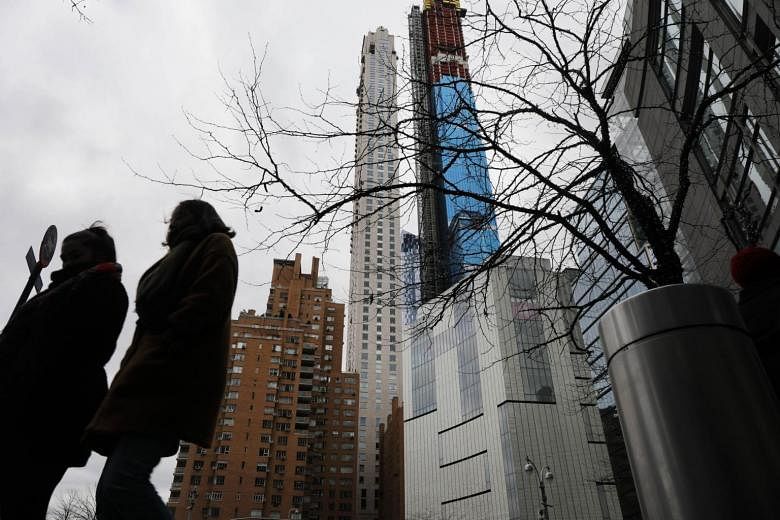NEW YORK (NYTIMES) - New York City is about to embark on an ambitious plan to fight climate change that would force thousands of large buildings, like the Empire State Building and Trump Tower, to sharply reduce their greenhouse gas emissions.
The legislation, expected to be passed by the City Council on Thursday (April 18), would set emission caps for many different types of buildings, with the goal of achieving a 40 per cent overall reduction of emissions by 2030.
Buildings that do not meet the caps could face steep fines.
The effort comes as New York, among other states, has undertaken a number of initiatives to reduce carbon emissions, and as the country debates the merits and necessity of the Green New Deal, the congressional proposal to tackle climate change and create new high-paying jobs in clean energy industries.
But New York City's move - opposed by real estate industry executives in part because of the associated costs to meet the new targets - may be unprecedented, according to Mr John Mandyck, the chief executive of the Urban Green Council, an umbrella group that includes real estate developers and environmental groups, among others.
"This is huge," Mr Mandyck said. "I haven't seen a city that has tackled climate change head-on in a way like this, setting specific targets for buildings and providing a path forward for how they can comply through innovative policy tools."
Buildings are among the biggest sources of greenhouse gas emissions because they use lots of energy for heating, cooling and lighting, and they tend to be inefficient, leaking heat in the winter and cool air in the summer through old windows or inadequate insulation.
An inventory of greenhouse gas emissions published in 2017 found that buildings accounted for 67 per cent of the city's emissions.
The legislation, part of a package of bills known as the Climate Mobilisation Act, comes after little progress was made during years of efforts to nudge, cajole or provide incentives to building owners to make voluntary cuts in energy use.
Mayor Bill de Blasio, who called the bill "very aggressive" during an unrelated news conference last week, has said that he would sign the legislation, and that his administration had worked closely with the council as it drafted the bill.
The mayor has been toying with running for president, and he has sought opportunities to project himself on a national stage as a champion of progressive causes, including as a leader in fighting climate change.
"It's going to revolutionise our ability to reduce emissions through our buildings which are really our No. 1 problem here in New York City," the mayor said.
The cost to building owners will be high.
Mr Mark Chambers, director of the Mayor's Office of Sustainability, said the cumulative cost to building owners to make the upgrades needed to meet the caps would exceed US$4 billion (S$5.4 billion). He added that building owners would eventually recoup those costs through lower operating expenses.
Many types of buildings were exempted from the caps, including houses of worship and apartment houses with rent-regulated units and other types of affordable housing. Those buildings are required to carry out several energy-saving measures, such as insulating pipes, but those measures fall well short of the costly steps required to meet the caps.
Real estate industry executives say that while they support reducing emissions, they believe too many types of buildings were given exemptions, placing an undue burden for reducing the city's greenhouse gas output on the remaining buildings.
Mr Chambers said that a new city agency that would be created by the law, the Office of Building Energy and Emissions Performance, would consider appeals from building owners and be empowered to give variances for tenants that have high energy needs.
"They would come to the city and explain that they have an outsize energy usage because of this particular use type, and their compliance path would be adjusted as a result," he said.
The maths of the law is complex. Many large buildings have been tracking and reporting their energy use and related factors for years - a process known as benchmarking - allowing the city to calculate the greenhouse gas emissions per square foot for individual buildings.
The caps set limits for different types of buildings, such as apartment houses or office buildings. For instance, the city's benchmarking website shows that the Empire State Building produces 6.27kg of carbon dioxide per square foot in the course of a year.
The cap would require it to emit just 4.53kg of CO2 per square foot in 2030, or pay a fine. Fines for large buildings could reach into the millions of dollars a year, depending on how far above the cap they are.
"New York City is a complicated, dynamic place with lots of old buildings and new buildings and hospitals and houses of worship and affordable apartments," said City Council speaker Corey Johnson. "So to craft a bill that would make a significant difference while at the same time understanding the variation of building stock was a challenge."

